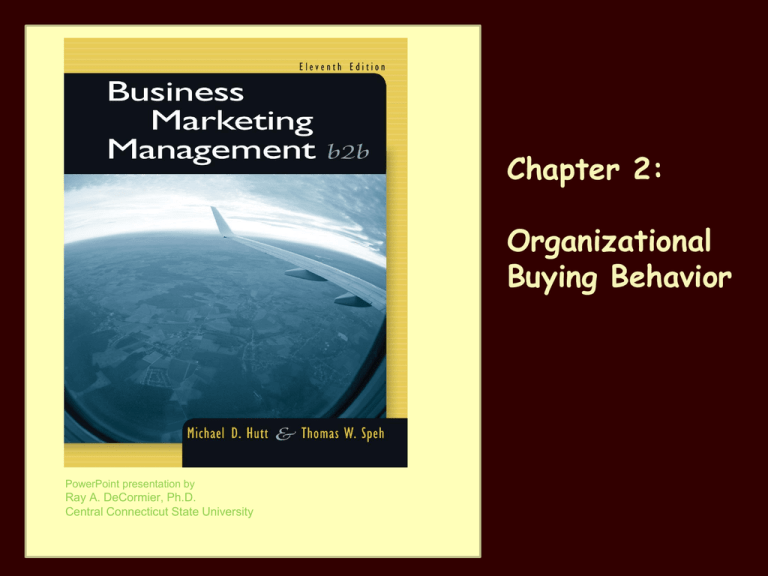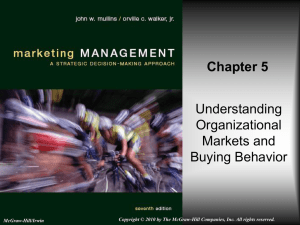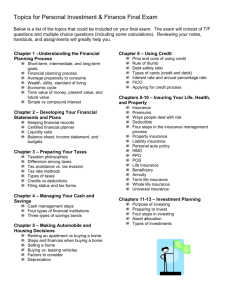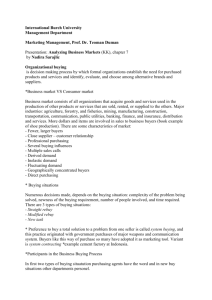
Chapter 2:
Organizational
Buying Behavior
PowerPoint presentation by
Ray A. DeCormier, Ph.D.
Central Connecticut State University
Developed by Cool Pictures and MultiMedia Presentations
Copyright © 2007 by South-Western, a division of Thomson Learning, Inc. All rights reserved.
Inside and outside forces influence organizational
buying. In this chapter you’ll learn about:
1.
2.
3.
4.
The organizational buying process
The four main factors that impact
organizational buying decisions
A model of organizational buying behavior
How knowledge of organizational buying
enables marketers to make more informed
decisions on product design, pricing and
promotion
2
UNDERSTANDING THE DYNAMICS
OF ORGANIZATIONAL BUYING
Market-driven firms sense market trends and work
closely with their customers and vendors. This is
crucial to:
Identify
profitable market segments
Locate buying influences within segments
Reach organizational buyers efficiently and
effectively with an offer
Each decision goes through various steps. Skipping a
step can be essential to the decision-making process.
Buying as a Process
Buying is a process, not an event
There are various points in the process that
are referred to as “Critical Decision Points”
and “Evolving Information Requirements”
It starts with “Problem Recognition”
Organizational Buying Process
1. Problem
Recognition
4. Supplier
Search
6. Supplier
Selection
2. General
Description
of Need
3. Product
Specifications
Organizational
Buying
Process
5. Acquisition
and Analysis
of Proposals
7. Selection
of
Order Routine
8. Performance
Review
1. Problem Recognition
• Before anything is bought, most
buyers need to be made aware
of a problem.
1. Problem Recognition
Internally:
A machine breaks down
Someone needs to order an MRO product
Someone recognizes an opportunity that
can be captured by acquiring the product
1. Problem Recognition
Externally:
More often than not, it is the salesperson who
precipitates the need for a new product
Advertising also can influence purchasing
Many organizations use the Push/Pull
Strategy
2. General Description of Need
Once a need is recognized, the purchasing department
works with the buying group to define what is needed by
asking:
• What is the extent of the problem?
• What alternatives can solve the problem?
• Where can the solution be purchased?
Each small decision ultimately helps define the product
specifications.
Sometimes the supplier is involved if the supplier
influences the sale (i.e., the supplier makes the buyer
aware of the need).
3. Product Specifications
Many times the question boils down to:
1.
2.
3.
Is it a new task buy?
Is it a straight rebuy?
Is it a modified rebuy?
Buyers try to be objective and consider many ideas.
Professional sellers try to influence this decision as early
as possible in the buying process—if they can!
3. Product Specifications
This is an important because it often
determines how the contract is structured
and the specific wording that it uses.
4. Supplier Search
Who will be the supplier?
The creating influencer has a lot of say
about the choice of supplier. If a
salesperson creates the need, often the
specs are written so that only the
salesperson’s organization is able to
fulfill the contract.
In established businesses, often only
preferred vendors are considered.
5. Acquisition and
Analysis of Proposals
• This step occurs only when the buying
organization lacks adequate information to
make a decision.
• Proposals are presented in detail often by
a team engineers, users and purchasing
agents. Successful proposals determine
the supplier.
• Many times, this step is perfunctory. The
buyer may have already determined the
preferred vendor, but legally it may be
necessary to seek other vendor proposals
to attain government contracts.
6. Supplier Selection
At this point, negotiation includes not only
monies, but also:
1.Quantities
2.Delivery times
3.Level of service
4.Warranties
5.Payment schedules
6.And a host of final details that determine
selection
7. Selection of Order Routine
Once the supplier is selected, the order
routines are established
8. Performance Review
After receipt of the product or service, a
performance review asks:
1.
2.
3.
4.
Did the supplier meet delivery time?
Did the product meet the specs?
Does the contract have to be modified?
Did the vendor live up to expectations?
Buying Process
Stages in the buying process are not as
sequential as suggested by the model.
Sometimes steps are skipped. For example, on
straight rebuys, buyers choose to purchase
almost immediately.
However, the model represents important
aspects of how companies buy and evaluate
business purchases.
Organizational Buying Process
1. Problem
Recognition
4. Supplier
Search
6. Supplier
Selection
2. General
Description
of Need
3. Product
Specifications
Organizational
Buying
Process
5. Acquisition
and Analysis
of Proposals
7. Selection
of
Order Routine
8. Performance
Review
Buying Process
There other events that influence the buying
process, most notably:
1.
2.
3.
4.
Economic conditions
Competition
Basic shifts in the organizational objectives
The buying situation
Three Buying Situations
1. New task
2. Straight rebuy
3. Modified rebuy
Three Buying Situations
1. New Task
•
New task – a perceived problem or need that is
totally different from previous experiences.
•
To solve it, buyers need a significant amount of
information.
•
Buyers & Influentials operate in a stage of decisionmaking known as “extensive problem solving”
because they lack:
• Well-defined criteria
• A strong predisposition toward a particular
solution
21
Developed by Cool Pictures and MultiMedia Presentations
Copyright © 2007 by South-Western, a division of Thomson Learning, Inc. All rights reserved.
1. New Task
There are 2 approaches to New Task purchasing:
1.
Judgmental Situations
2.
Strategic Decisions
New Task - Judgmental Situations
This is the greatest amount of uncertainty because there
is little information or experience to support a decision.
To overcome this, decision-makers conduct outside
research to analyze key aspects of the buying decision.
An example of key questions might include:
What kind and model of production equipment should we
purchase?
Who are the available suppliers?
Will they provide the services we need?
New Task - Strategic Decisions
This level of New Task purchasing is the most
important because it concerns long-range
planning, larger investments and increased risk
if they are wrong.
An example of strategic questioning might
include:
– Should we develop a new product line which
demands us to buy new machinery, retool what we
have, and maybe even hire a different type of
employee?
– What should we do?
Marketing Consideration for
New Task Buys
Marketers can gain an edge if they:
1. Initiate problem recognition
2. Get involved very early in the decisionmaking process
3. Get involved early in the procurement
process
4. Understand the buying organization's
behavior patterns
New Task Marketer’s Edge
• If a marketer is already established
with an account, often he or she can
leverage that situation into further
business.
• This is why present suppliers continue
to develop further business with their
customers—they understand their
prospects’ buying philosophy,
developing situations and contacts.
• They can also create need since the
prospect trusts them.
Three Buying Situations – A Review
1. New task
2. Straight rebuy
3. Modified rebuy
Three Buying Situations
2. Straight Rebuy
Straight rebuy – a problem or need that is
recurring or a continuing requirement.
– Buyers have experience in the area
– Require little or no new information
– Buyers operate in routine problem-solving
stage
Buying Decision Approaches
Casual purchases: Involve no information search or analysis.
Routine low priority: Decisions are more important and
involve a moderate amount of analysis.
Straight Rebuy
Routine problem solving situations
requiring routine solutions.
This is the repeat business situation
that every major supplier desires.
MOR: Maintenance, Operation and
Repair items fall into this category as
do various services such as travel.
Straight Rebuy
Many companies review this area of business
every now and then, but the edge usually
goes to the supplying company.
Relationships become very important.
Marketing Challenges to Straight Rebuy
Purchasing departments handle this situation in
most cases; the determinant is who is “IN” and
who is “OUT”?
“IN” seller needs to constantly reinforce their
services, meet buying expectations, continue
developing relationships and be responsive to
changing needs.
“OUT” sellers have a much more difficult task.
Buying Companies Risk to Change
Vendors – Straight Rebuys
The buying company is usually reluctant to
change because “OUT” sellers are unknown,
they are a big risk, and change is expensive.
The old adage is: “If it ain’t broke, don’t fix it.”
Out Sellers in Straight Rebuy
To get in, OUT sellers need to convince the
buying organization that:
1. Their current supplier is not doing their job.
2. They are experiencing problems that they
were not aware of earlier.
3. Their purchasing requirements have changed.
4. They should consider other alternatives.
Modified rebuy—Decision makers feel there is a
benefits to reevaluating alternatives.
Internal Forces:
Search for quality improvement
Cost reductions
Buyers feel they can make significant advances if
they review their buying situations on a regular basis.
Often, changes in styles, materials or even
alternative solutions facilitate this review.
Another reason for Modified Rebuy is dissatisfaction
with present supplier.
New supplier was able to find the present supplier’s
weaknesses and offered buyers new alternatives to
“fix” their problem(s).
Modified Rebuy:
Limited Problem Solving
When a company has to replace a
broken part, they may bypass the
manufacturer and go to a supplier of
comparable upgrades.
Example: Your IBM printer breaks so
you consider an HP printer instead.
BUYING DECISION APPROACHES
Simple
Modified Rebuy: Involves
narrow choices and minimal research.
The
major area of consideration is
supplier relationship.
Complex
Modified Rebuy: Involves
larger items, more research, extensive
specification development, a
competitive bidding process and longterm relationship development with
new supplier(s).
IN verses OUT Suppliers
IN suppliers need to understand
developments within the buying organization
so they can be a part of the modified rebuy
situation. They generally have an edge
unless they are “out of touch” with the buyer.
IN verses OUT Suppliers
• OUT suppliers need to create the need
and influence the buying organization to
consider other alternatives. This
demands superior salespersonship.
• Selling company needs to offer
performance guarantees, warranties and
often additional services and training.
Vested Interest
Developing a vested interest on the part of
both the buyer and seller is important to
perpetuating the business.
Questions:
1. Did the selling organization put in enough
effort to show serious involvement?
2. Is the buying organization trapped in a
buying decision, making it difficult to get
out?
Business Strategy Considerations
The business marketer must
always try to understand the sale
from the buyer’s perspective and
do everything to make it easier for
the buyer to buy.
Business Strategy Considerations
Marketers needs to understand:
1.
2.
3.
4.
Who are the decision makers?
What are their problem(s)?
What are their purchasing patterns?
What is the importance of their
purchase?
5. What is the timing of the purchase?
Forces Influencing Organizational Buying
Behavior
A projected change in
business conditions
can alter buying plans
drastically.
Organizational
Buying
Behavior
Environmental
Forces
• Economic outlook:
domestic & global
• Pace of technological
change
• Global trade relations
Organizational
Forces
• Goals, objectives and
strategies
• Organizational position
of purchasing
Group
Forces
• Roles, relative
influence and patterns
of interaction of buying
decision participants
Individual
Forces
•Job function, past
experience, and buying
motives of individual
decision participants
Environmental Forces - Economic Influences
Changes in the environment such as business
conditions, technological advances or new
legislation can affect buying plans.
Since much of business is driven by derived
demand, business marketers must be sensitive
to changes in the consumer market.
Also, the economy can determine a company’s
ability or willingness to buy. If the economy is
bad, companies often put off purchasing until
they see a change.
Economic Influences
Not all companies are affected equally.
For example, high interest rates may
affect housing starts but may not affect
food products, medical or transportation
services.
Finally, there is an affect from foreign
competitors such as China and India.
Both have strong labor saving costs as a
competitive advantage.
Technological Influences
• Technology is changing so quickly that yesterday’s
technological advancement is today’s electronic
commodity.
Example: Computers
• However, all companies need to stay alert to these
changes. For example, Blockbuster is feeling the pinch
of Netflix, Internet and satellite movies-on-demand.
• Technological change—especially from the Internet—is
drastically changing the way companies do business.
Technological Change
The Internet has leveled the playing field,
allowing competitors the opportunity to compete
in the world’s most technological advanced
countries.
It affects not only entire companies (the printing
industry is struggling due to digital printing and
electronic communication), but also individual
careers (an “A” programmer in India can be
purchased for $2-4/hour).
Organizational Forces &
Growing Influence of Purchasing
As manufacturing has become less
important, purchasing and procurement
have become more important.
Companies are outsourcing many
activities such as manufacturing,
marketing, accounting, etc., yet
procurement remains a strong influence
resulting in a shift to more professional
procurement positions.
Strategic Priorities in
Purchasing
• As the purchasing profession grows, so
do its goals and priorities.
• Purchasers are more ambitious, resulting
in a more competitive environment. An
effective marketing strategy develops
stronger and deeper relationships with
purchasers.
• This is the impetus for Relationship
Marketing.
STRATEGIC PRIORITIES IN PURCHASING
Aligning Purchasing
with Strategy,
Not Just Buyers
Shift from administrative role
to value-creating function that
serves internal stakeholders
and provides competitive edge
in market.
Exploring New
Value Frontiers:
It’s Not Just About
Price
Focus on suppliers’
capabilities, emphasizing
business outcomes, total
ownership costs, and potential
for long-term value creation.
Source: Adapted from Marc Bourde, Charlie Hawker, and Theo Theocharides, “Taking Center Stage: The 2005 Chief
Procurement Officer Survey,” (Somers NY: IBM Global Services, May 2005), pp. 1-14. Accessed at http://www.ibm.com/bcs
on July 1, 2005.
STRATEGIC PRIORITIES IN PURCHASING
Putting Suppliers Inside:
The Best Value Chain Wins
Pursuing Low-Cost Sources:
A World Worth Exploring
Develop fewer and deeper
relationships with strategic
suppliers and involve them in
decision- making processes,
ranging from new product
development to cost-reduction
initiatives.
Overcome hurdles imposed by
geographical differences and
seek out cost-effective
suppliers around globe.
Marketing Strategic
Considerations
As Purchasers develop their strategic roles, Marketers
respond by developing strategic alliances to become a
part of their business.
Buyers and Sellers know that “the best value supply
chain wins” the customer…and the profits.
The result is closer relationships with carefully chosen
suppliers who can align their activities with customer
needs.
Example: At this time in history, Walmart is one of the
best at accomplishing this activity!
Procurement Manager’s Toolkit
Total Cost of Ownership
TCO considers the full range of
costs associated with the purchase
and use of a product or service over its
complete life cycle.
54
TCO
1. Acquisition costs: selling price and transportation
costs & administrative costs of evaluating suppliers,
expediting orders, and correcting errors in shipments
or delivery.
2. Possession costs: include financing, storage,
inspection, taxes, insurance, and other internal handling
costs.
3. Usage costs: are those associated with ongoing use
of the purchased product such as installation, employee
training, user labor, and field repair, as well as
product replacement and disposal costs.
55
Value-based Selling Tools
56
Astute business marketers can pursue valuebased strategies that provide customers with
a lower cost-in-use solution.
Value-based strategies seek to move the
selling proposition from one that centers on
current prices and individual transactions to a
longer-term relationship built on value and
lower total cost-in-use.
SEGMENTING THE BUY
57
Various categories of purchases are
segmented on the basis of procurement
complexity and the nature of the effect on
corporate performance
Use a segmentation approach to isolate
those purchase categories that have the
greatest effect on corporate revenues
E-Procurement
• Purchasing managers use the Internet to
find new suppliers, communicate with
current suppliers, or place an order.
• E-procurement cut purchasing cycle time
in half, reduced material costs by 14
percent and purchasing administrative
costs by 60 percent, and enhanced the
ability of procurement units to identify new
suppliers on a global scale.
58
Reverse Auctions
• Involves one buyer who invites bids from
several prequalified suppliers who face off in
a dynamic, real-time, competitive bidding
process.
• Reverse auctions are best suited for
commodity-type items such as purchasing
materials, diesel fuel, metal parts, chemicals,
and many raw materials
59
A Strategic Approach to Reverse
Auctions
60
“Preempt the auction: convince the buyer not to go
forward with the auction because you have a
unique value proposition and are not inclined to
participate.
Manage the process: influence bid specifications
and vendor qualification criteria.
Walk away: simply refuse to participate
Centralized vs. Decentralized
Purchasing
Purchasing is moving away from a
transaction-based support role to a more
strategic, executive level role
One result of this is to centralize purchasing
Centralized purchasing operates differently
than decentralized purchasing
Decentralized Purchasing
• Decentralized purchasing allows local
branches to purchase what they need.
This results in local control, and for many
kinds of services this makes sense.
• Example: Stop and Shop buys products
from local farmers.
MARKETING STRATEGY RESPONSE
The organization of the marketer’s selling
strategy should parallel the organization of
the purchasing function of key accounts.
To avoid disjointed selling activities and internal
conflict in the sales organization, and to serve the
special needs of important customers, many
business marketers have developed key account
management programs.
Develop strategic relationships with a limited
number of customers in order to achieve longterm, sustained, significant, and measurable
business value for both the customer and the
provider
Industrial Sales: How to Assess Group Forces
There are three questions that need to be addressed:
1. Who takes part in the buying process?
2. What is each member’s relative influence in
decision?
3. What criteria is important to each member in
evaluating the supplier?
Answering these questions puts the salesperson in a
better position to become the chosen supplier.
Developed by Cool Pictures and MultiMedia Presentations
Copyright © 2007 by South-Western, a division of Thomson Learning, Inc. All rights reserved.
Roles in the Buying Center
8
Initiator
Influencers
Gatekeepers
Decider
Purchaser
Users
Buying Center Roles
Initiator
Initially perceives a problem and initiates the buying
process to solve it.
Influencer
Affects the purchasing decision by providing technical
information or other relevant (internal or external)
information.
Gatekeeper
Controls the information to be reviewed by members of
the buying group. (For example, buyer may screen
advertising material and even salespeople.)
Decider
Actually makes the buying decision, whether or not
they have formal authority to do so. Could be the
owner, an engineer or even the buyer.
Buyer
Has formal authority to select and purchase products
or services and the responsibility to implement and
follow all procurement procedures.
User
Actually use the product in question. Can be
inconsequential or major players in the process.
Buying Center Members
Members of the buying center assume different
roles throughout the procurement process.
1. Isolate the personal stakeholders
Clues to help
identify powerful
buying center
members:
2. Follow the information flow
3. Identify the experts
4. Trace the connections to the top
5. Understand purchasing’s role
SOURCE: Adapted from John R. Ronchetto, Michael D. Hutt, and Peter H. Reingen, “Embedded Influence
Patterns in Organizational Buying Systems,’ Journal of Marketing 53 (October 1989), pp. 51-62.
Isolating the Buying Situation
Since buying is a process and not an event,
one needs to understand who affects the
potential sale and how they affect it.
One method is to isolate the sale. That
means to define the buying situation and
to understand what stage it is in. Effective
salespeople create a need, whereas less
effective salespeople become involved
later in the buying process.
Strategy to Isolate the Sale
• Depending upon the product, selling companies
that have new-buy products must:
– Create a need
– Get involved in the early stages of the buying process
Strategy to Isolate the Sale
• For more established type products (MRO), the
strategy should be to:
–
–
–
–
–
Get a foothold
Start small
Learn the company
Offer better deals
Be ready to offer more as buying/selling opportunities
occur
Clues for Identifying
Powerful Buying Center Members
1.
Isolate personal stakeholders. Who has
the most to gain and/or lose?
2.
Follow the information flow. Influencers
are usually the ones who actually
facilitate the exchange.
3.
Identify the experts. Experts ask the
most questions, exhibit the most
knowledge, and are often the most
influential.
Clues for Identifying
Powerful Buying Center Members
4. Trace the communication to the top. Who
are the decision makers?
5. Make sure you understand purchasing’s
role. Often purchasers are not decision
makers, but they may be the bargainers.
In repeat buying situations, they are
usually dominant players because of their
specialization.
Who Makes the Decision?
Individuals make the decision, not
organizations!
Each member has a unique
personality, experience and motive,
and are subject to risk and rewards.
Professional marketers understand
this and make sure that they learn to
recognize and match to it.
Evaluative Criteria
Industrial product users value:
1.
Prompt delivery
2.
Efficient and effective service
Engineering values:
1.
Product quality
2.
Standardization
3.
Testing
Purchasing values:
1.
Price advantage and economy
2.
Shipping and forwarding
Evaluative Differences
1.
2.
Education: Engineers have a different
educational background than purchasing
agents.
Also, various occupations have different
dispositions. For example:
Engineers are usually cold, analytical and
suspecting.
Salespeople are usually warm, open and
optimistic.
Marketing Response
By understanding the buying process and the
various roles that link the buying group
together, the marketer is in a better position to
match with them by working with the right
people and the appropriate sales process.
Selective Processes in
Information Processing
Selective exposure.
Selective attention.
Selective perception.
Selective retention.
Selective Exposure
Individuals accept communication
messages consistent with their
attitudes and beliefs.
This is why buyers will choose to
talk to some salespeople and not to
others.
Selective Attention
People filter out stimuli only to allow certain
ones to cognition. For example, buyers will
notice certain ads that can solve a perceived
need.
Selective Perception
People interpret stimuli in terms of their
attitudes and beliefs.
This explains why buyers may modify or
change their disposition to a salesperson in
order to make it more consistent with their
predisposition towards the company.
They like the company so they may like the
salesperson.
Selective Retention
People recall information that pertains to
their own needs and dispositions.
For example, a buyer may remember
information about a certain brand because
it elicits a reaction that is consistent with
his/her criteria.
Selective Process
Each of those selective exposures elicits a
reaction that influences the buyers’ actions.
Since procurement activities often span a
great deal of time, it is imperative for
marketers to carefully design and target
their marketing communications.
Salespeople who understand and adjust to
buyer psychological needs are usually more
successful than those who are not cognizant
or considerate of those needs.
Risk-Reduction
Most people are adverse to risk,
especially buyers. Great risk can
mean great loss and buyers can get
fired for that.
There are two components to
perceived risk. They are…
Perceived Risk Components
1. Uncertainty about decision
outcomes.
2. Magnitude of consequences
associated with making a
wrong selection.
Confronting Risk
• The larger the purchase, the more influential
the buying center becomes and can often
include higher ranking members.
• There is an extensive outside search to see
what others are doing in similar situations.
• Sellers who have a proven track record are
favored.







